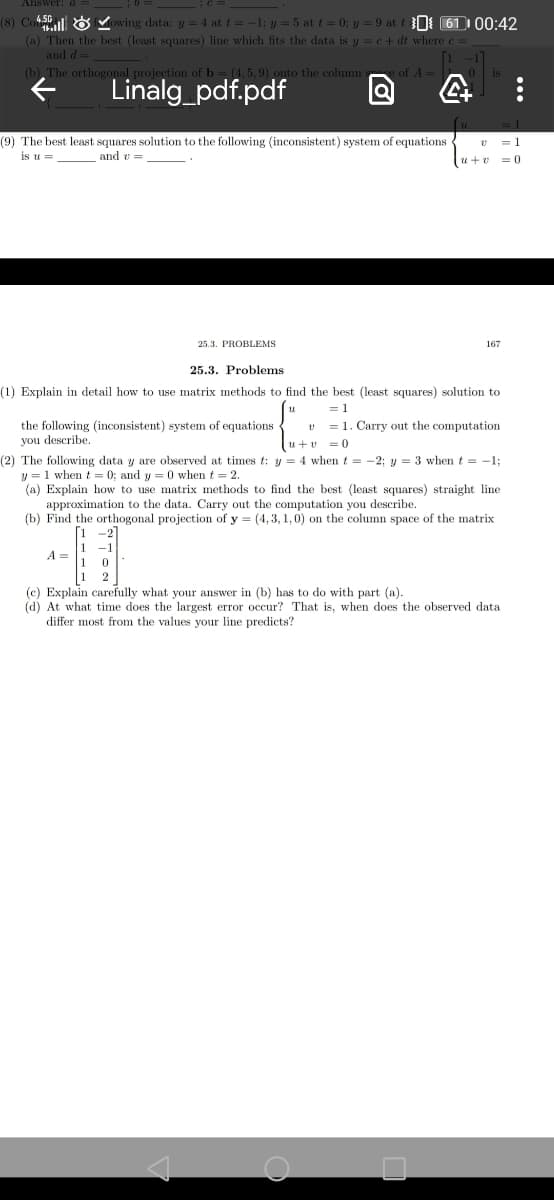(1) Explain in detail how to use matrix methods to find the best (least squares) solution to = 1 the following (inconsistent) system of equations you describe. = 1. Carry out the computation
(1) Explain in detail how to use matrix methods to find the best (least squares) solution to = 1 the following (inconsistent) system of equations you describe. = 1. Carry out the computation
Linear Algebra: A Modern Introduction
4th Edition
ISBN:9781285463247
Author:David Poole
Publisher:David Poole
Chapter7: Distance And Approximation
Section7.3: Least Squares Approximation
Problem 32EQ
Related questions
Question

Transcribed Image Text:(8) Co5l O Mowing data: y = 4 at t = -1; y = 5 at t = 0; y = 9 at t 1 61 I 00:42
(a) Then the best (least squares) line which fits the data is y = c+ dt where c=
and d=
(b), The orthogonal projection of b = (4,5, 9) onto the column
of A =
Linalg_pdf.pdf
= 1
(9) The best least squares solution to the following (inconsistent) system of equations·
is u =
v =1
and e=
u +v = 0
25.3. PROBLEMS
167
25.3. Problems
(1) Explain in detail how to use matrix methods to find the best (least squares) solution to
= 1
v = 1. Carry out the computation
the following (inconsistent) system of equations
you describe,
u+v = 0
(2) The following data y are observed at times t: y = 4 when t = -2; y = 3 when t = -1;
= 1 when t = 0; and y = 0 when t = 2.
(a) Explain how to use matrix methods to find the best (least squares) straight line
approximation to the data. Carry out the computation you describe.
(b) Find the orthogonal projection of y = (4, 3, 1,0) on the column space of the matrix
[1
1 -1
A3=
1 0
1 2
(c) Explain carefully what your answer in (b) has to do with part (a).
(d) At what time does the largest error occur? That is, when does the observed data
differ most from the values your line predicts?
Expert Solution
This question has been solved!
Explore an expertly crafted, step-by-step solution for a thorough understanding of key concepts.
Step by step
Solved in 2 steps

Knowledge Booster
Learn more about
Need a deep-dive on the concept behind this application? Look no further. Learn more about this topic, algebra and related others by exploring similar questions and additional content below.Recommended textbooks for you

Linear Algebra: A Modern Introduction
Algebra
ISBN:
9781285463247
Author:
David Poole
Publisher:
Cengage Learning

Algebra & Trigonometry with Analytic Geometry
Algebra
ISBN:
9781133382119
Author:
Swokowski
Publisher:
Cengage

Linear Algebra: A Modern Introduction
Algebra
ISBN:
9781285463247
Author:
David Poole
Publisher:
Cengage Learning

Algebra & Trigonometry with Analytic Geometry
Algebra
ISBN:
9781133382119
Author:
Swokowski
Publisher:
Cengage